In the midst of revisions season, everything is up for re-evaluation. Some end up as big changes, others mere footnotes. A lot has been revised (lower) about the past few years, particularly surrounding the substantial downturn at the end of 2015. Inflation rates are not among that list. The PCE Deflator has been given only mild benchmark revisions in contrast to the rest of the PCE series (especially the Personal Savings Rate).
As a result of them, the Federal Reserve can now technically count two months of success instead of one. The inflation index value for January 2017 was revised just slightly higher, while for January 2016 just slightly lower, working out to 2.03% inflation to start this year rather than the previously estimated 1.94%. Two months out of the last 62 is still as unimpressive as it otherwise appears (particularly when oil prices are the reason for both).
In any case, the latest figure is back to 1.42%, the same meandering level as the middle of last year before WTI’s base effects kicked in to inappropriately arouse mainstream hope. As I’ve written before, the issue of inflation is not strictly consumer prices. The Federal Reserve has committed itself to doing whatever monetarily in order to bring about a sustainable 2% rise in inflation. Instead, like Japan, it can’t come close without outside assistance.
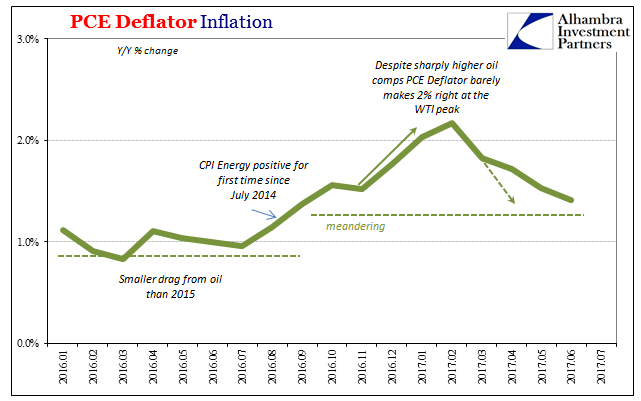
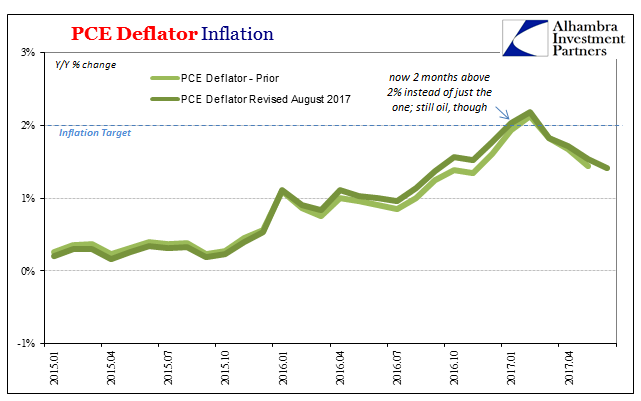
This is mystifying largely because of still the legend of Alan Greenspan. During especially the decade of the 1990’s, the “maestro” could seemingly conjure ideal economic conditions from minor changes to nothing more than the federal funds rate. A central bank that could accomplish so much by doing so little should easily be able to get whatever it wants when it does a great deal, right?
Inflation is a check of monetary assumptions, the more visible aspects to the hidden reactions and interactions of money in the economy. It’s not that 2% or any level of inflation is good, but central banks are supposed to be the center of the monetary universe and if they can’t get consumer prices to dance to their tune then something is very wrong.
Alan Greenspan agrees, which is why he consistently proclaims that an explosion of inflation is right around the corner. He prominently declared it in 2013 during that “reflation”, then again in 2015 right in between destructive waves of global “dollar” shortages, and today he has increased his intensity and is warning of the very violent end to the so-called bond bubble (thanks to M Simmons).
By any measure, real long-term interest rates are much too low and therefore unsustainable. When they move higher they are likely to move reasonably fast. We are experiencing a bubble, not in stock prices but in bond prices. This is not discounted in the marketplace.
Or, maybe it is discounted in everything from UST’s to eurodollar futures, from German bunds and WTI futures, just not in the way Greenspan or many economists would like. In that Bloomberg article publishing the former Fed Chairman’s quote, it never once states why; as in why must the bond bubble end? We know what he expects as far as real-term rates: as inflation will surely rise in the coming months, he and those like him claim, bond investors will be forced to demand a much higher premium in interest payments to compensate for the lost purchasing power. The result would be, of course, another bond massacre like 1994.
But why must inflation rise? Nobody knows. It just will, apparently.
Tom Porcelli, chief U.S. economist at RBC Capital Markets, says it’s only a matter of time before inflationary pressures hit the bond market.
You can see the problem already, because expectations such as these are nothing more than articles of faith. They are not analysis, which is why ten years after the first instance of crisis we are still talking about a recovery without having yet obtained even a slight one. For economists, this money stuff is pretty simple; the Fed commands and the market obeys. There is no challenge to the printing press.
That’s only one version, however, the one where Alan Greenspan is a legend. From this view, the FOMC meeting once every six weeks or so and on a completely discretionary basis (no money supply or demand inputs whatsoever) moving the federal funds rate a quarter point here or there and controlling the whole US economy and market system as a result isn’t as ridiculous as it sounds. And it sounds absolutely absurd.
But if you believe this is what happened in the 1990’s, then how do you explain the last ten years? That starts importantly with a full-blown, global panic that central bankers like Alan Greenspan and Ben Bernanke once said was impossible (the latter particularly in 2002, even referencing the printing press to justify this stance). It has only been downhill from there.
Accounting for this enormous discrepancy requires nothing less than rethinking the Great “Moderation.” From a wider perspective, it sure seems like the Federal Reserve, as other central banks around the world, were really spectators all this time. The minor fine tuning of the federal funds rate was but a comedy, or PR for what was really taking place behind the scenes. How else do we explain the asset bubble parts of what was supposed to be “moderation?”
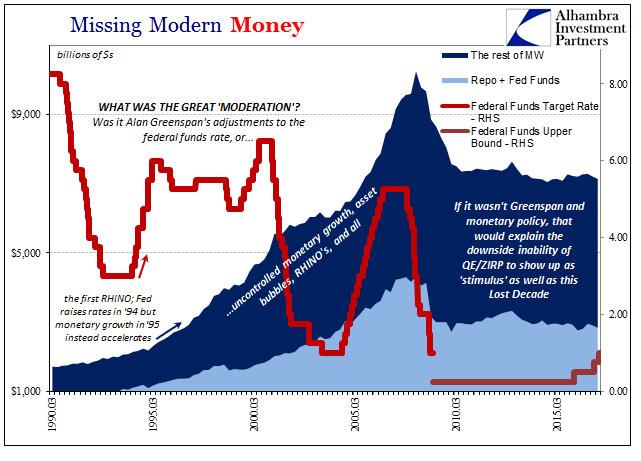
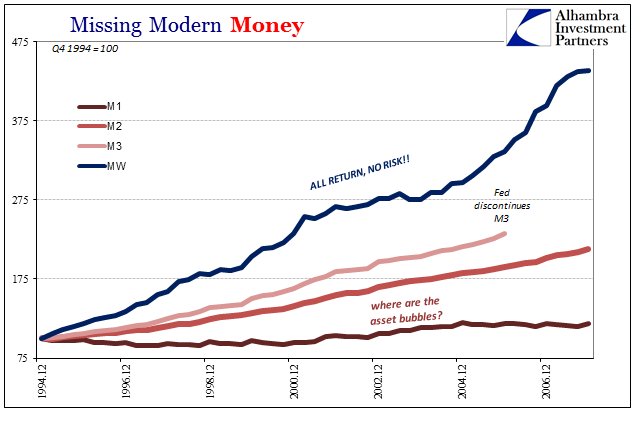
Thus, if the Fed and monetary policy was largely irrelevant in the first period, it would stand to reason that it would be again in the second, just as it appears. The dividing line between them is that “impossible” panic. When the global monetary system was on its own growing at often breathtaking rates, Alan Greenspan’s Fed looked competent; when it was contracting, Ben Bernanke’s Fed couldn’t do anything right (if you have to repeat QE even one additional time, let alone three more, it didn’t work).
The difference in monetary policy is not Greenspan to Bernanke (or Yellen) but that there hasn’t been any money in monetary policy in a very long time. It has been instead presumed that there was and is. The post-crisis period has been one painful experiment proving, unambiguously, those assumptions false.
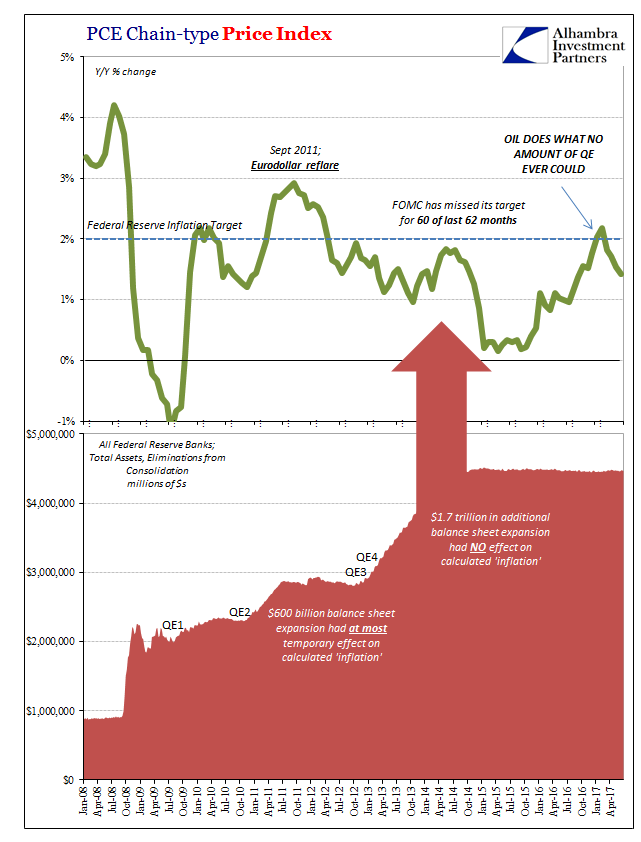
Therefore, convention that expects inflation to rise in the second half of 2017, just as it did for the second half of 2014 or 2012, is predicated on what is really just disproved faith. Like a scene from the Wizard of Oz, this Lost Decade has rudely ripped open the curtain exposing the Maestro as a mere confused mortal deploying a lot of the same Hollywood smoke and mirrors. Is it any wonder that in the world’s most desperate moments of monetary need, this central bank in particular always and in every possible way comes up short?
“Interest rates have nowhere to go but up” is an anachronistic cliché, not rational analysis. It is fitting, perhaps, that the day immediately following the Maestro declaring the bubble ripe, the bond massacre at the ready, UST’s rallied substantially on still more weak economic data. Like some aging movie actor who long ago slipped from fame, markets don’t pay much attention to Alan Greenspan anymore. They, especially UST’s and eurodollars, long ago recognized the canard.
The media, however, loves him again because what he says would if it happened vindicate their position, that populism is predicated on racism or xenophobia rather than a legitimate complaint that the “elites” really don’t know what they are doing. Again, it’s not really a lucid or scientific way to consider these circumstances.
